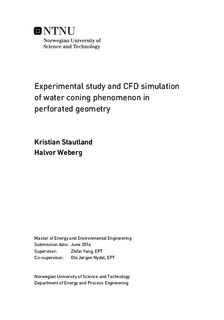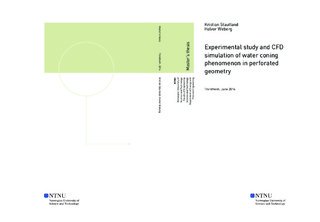| dc.description.abstract | The focus of this thesis is to further examine the water coning phenomenon in annular geometry
in a horizontal well completion. This phenomenon is of particular interest to the oil & gas
industry, as it may restrict production rates, and lead to reduced production effectiveness due
to water carry-over. An overview of industry experience and a review of academic research conducted
on the topic of water coning phenomenon is provided. The study has been carried out
by conducting experiments of flow inside annular geometry of a horizontal well in a laboratory
setup and by utilizing CFD simulations. The experimental findings provided valuable inputs
for the CFD simulations, and the CFD simulations may in turn become a useful tool for testing
ICD designs. Furthermore, this study provides a detailed analysis and comparison of analytical
methods that can be utilized to predict critical flow rates.
The experiments were conducted using a simple, yet effective, setup with a symmetric inflow of
the liquids. It was based on a 2D-principle giving good visualization of the experiments. The
main emphasis was placed on the single orifice geometry, but geometries with two orifices were
also used during the experiments. Two different oils were used: Nexbase 3080 due to its similarity
to the North Sea oil regarding viscosity, andMarcol 52 to have an oil with a viscosity between
those of water and Nexbase.
A total 766 experimental runs were conducted. From these experiments the effect of water coning
was studied in regard to the size of the annulus gap ±, the flow rate, the type of oil, different
plate geometries with one and two outlet orifices, and the distance between the water level and
the orifice.
The results indicated that water coning features are highly dependent on and all of the parameters
mentioned above. High flow rates and a short distance between the initial water level and
the orifice, both give a high tendency of water coning and large water cuts. However, large annulus
gaps lower the tendency of water coning. Nexbase oil with its high viscosity demonstrated
a larger tendency to induce water coning than the less viscous Marcol oil. Low flow rates, large
annulus gaps and large distances between the water level and the orificewillminimize the effect of water coning.
A powerful and versatile CFD package that is well equipped to simulate coning phenomenon,
ANSYS-CFX commercial code was utilized for running simulations. A total of 210 simulations
were set up and conducted, both in 2D and 3D.
For this research study, it was important to conduct a large number of simulations in order to
correctly observe trends when changing the input variables. The simulations were all planned
to ensure that an acceptable step size in variable changes was utilized. In this manner it was
possible to stay within a reasonable number of simulations while still being able to uncover
trends fromflow behaviour.
The CFD-simulations conducted indicated that the two-dimensional modeling approach was
effective to study water coning phenomenon, in that the simulations displayed the same underlying
trends observed in the experiments, and required a relatively short amount of computational
time.
The main focus of the analytical aspect of this study is directed towards a pressure balance analysis.
However, dimensional analysis was utilized to forge a correlation for the critical flow rate.
The comparisons of the different analyticalmethods indicate that the dimensional analysis approachmay
provide valuable insight to critical flow rates. Comparisons with experimental data
suggest that the analytical expression derived from pressure balances leads to a largely varying
magnitude of discrepancy depending on the case in question. | |

